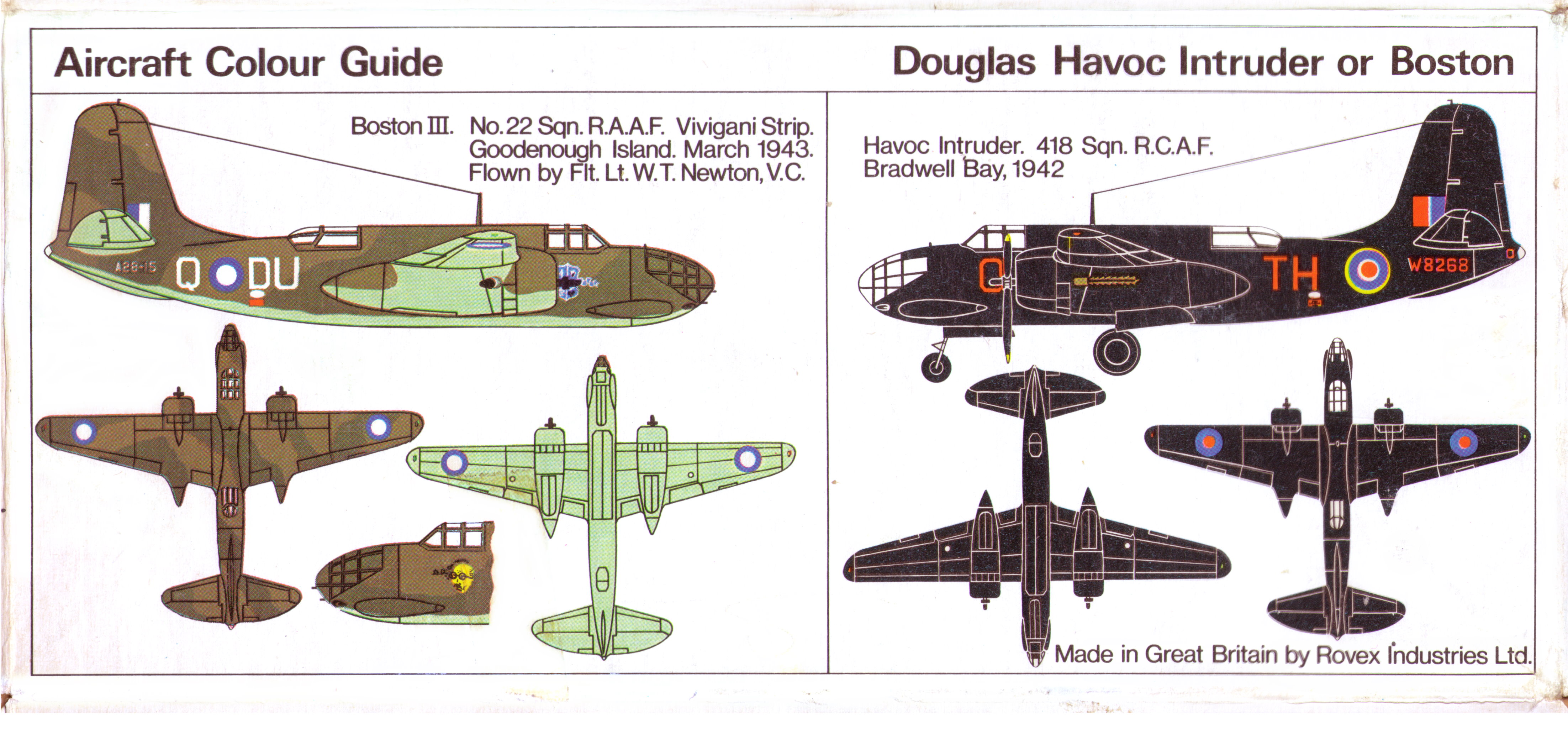



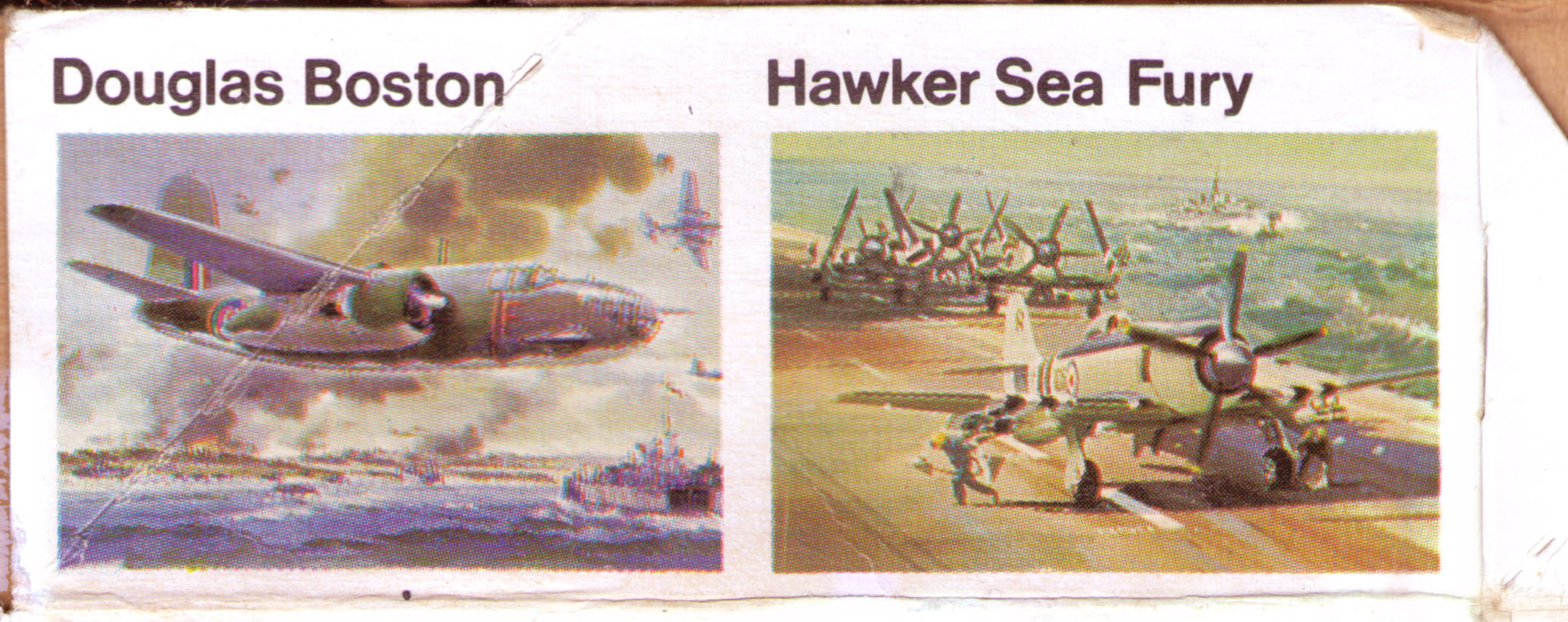
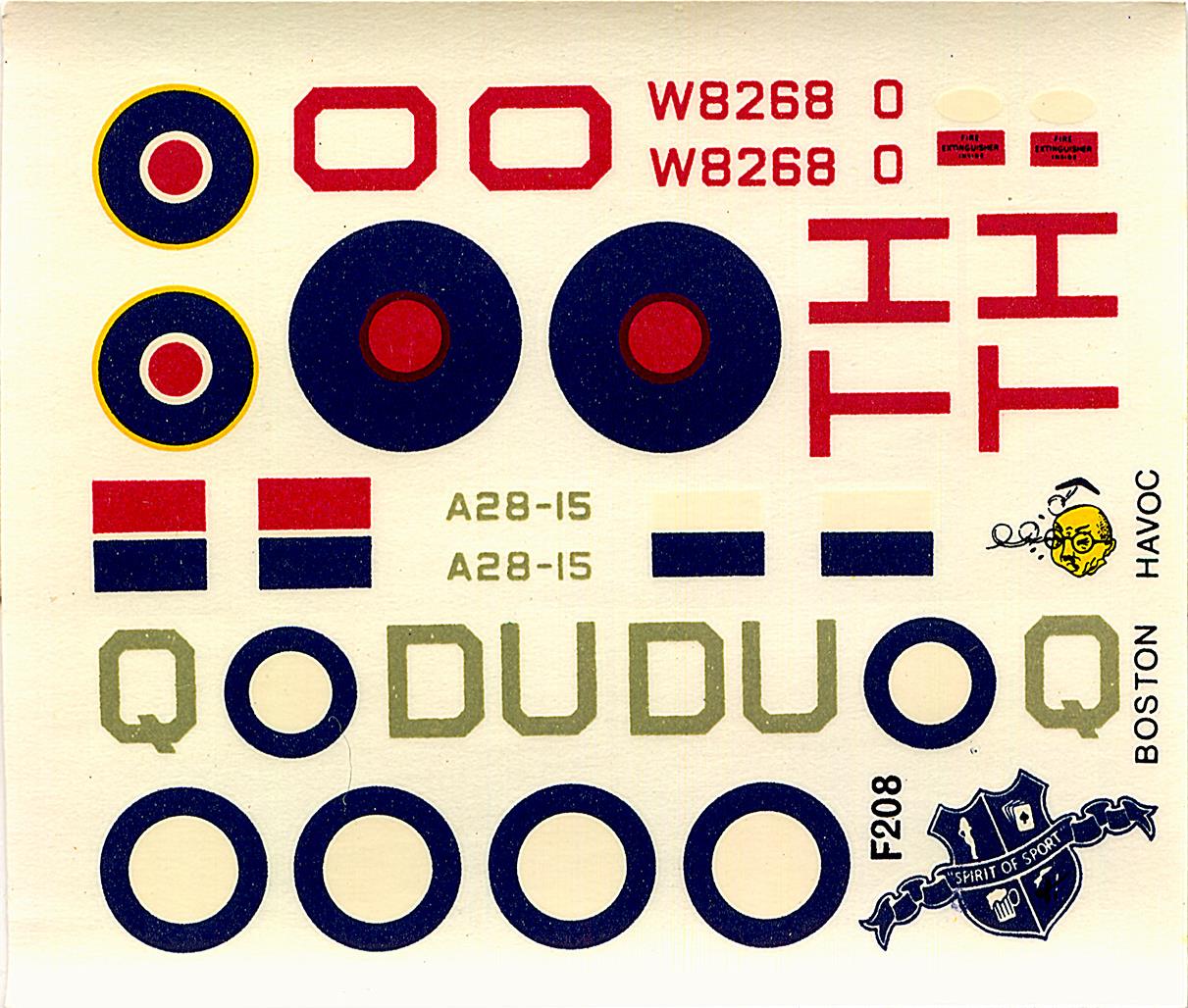
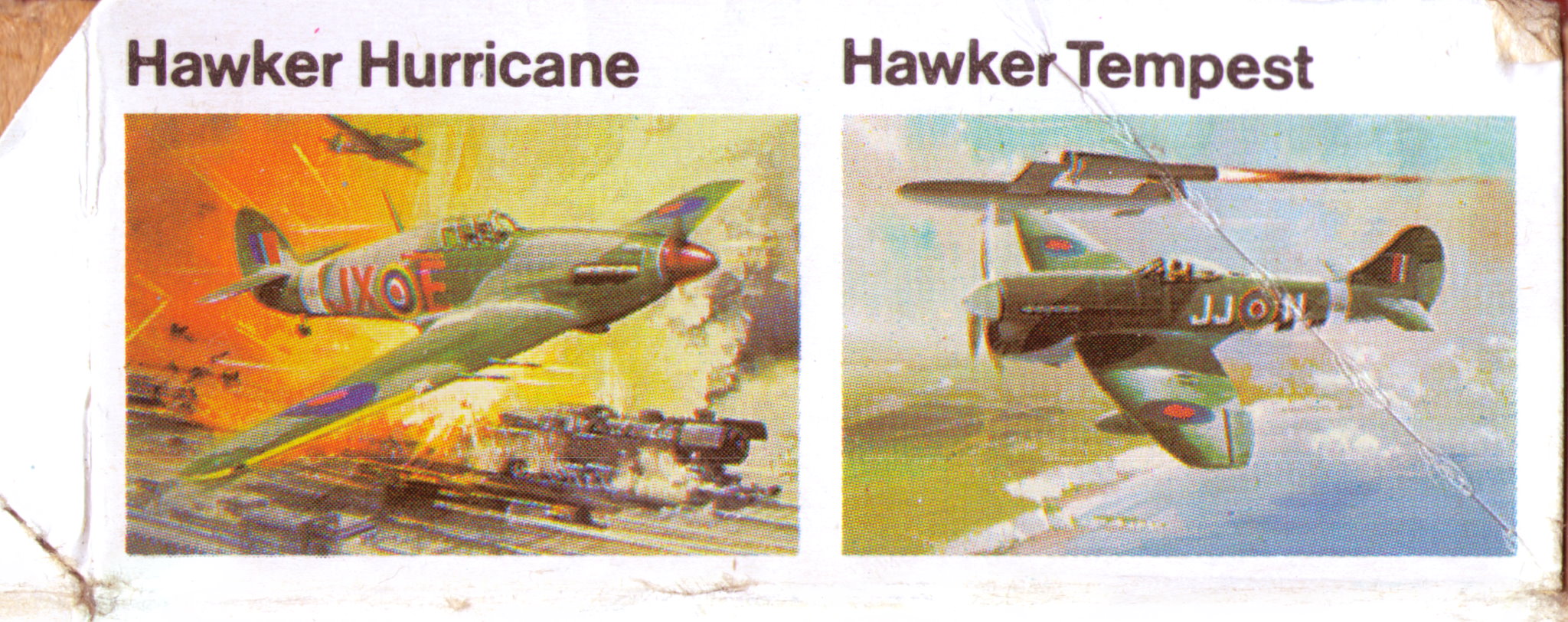
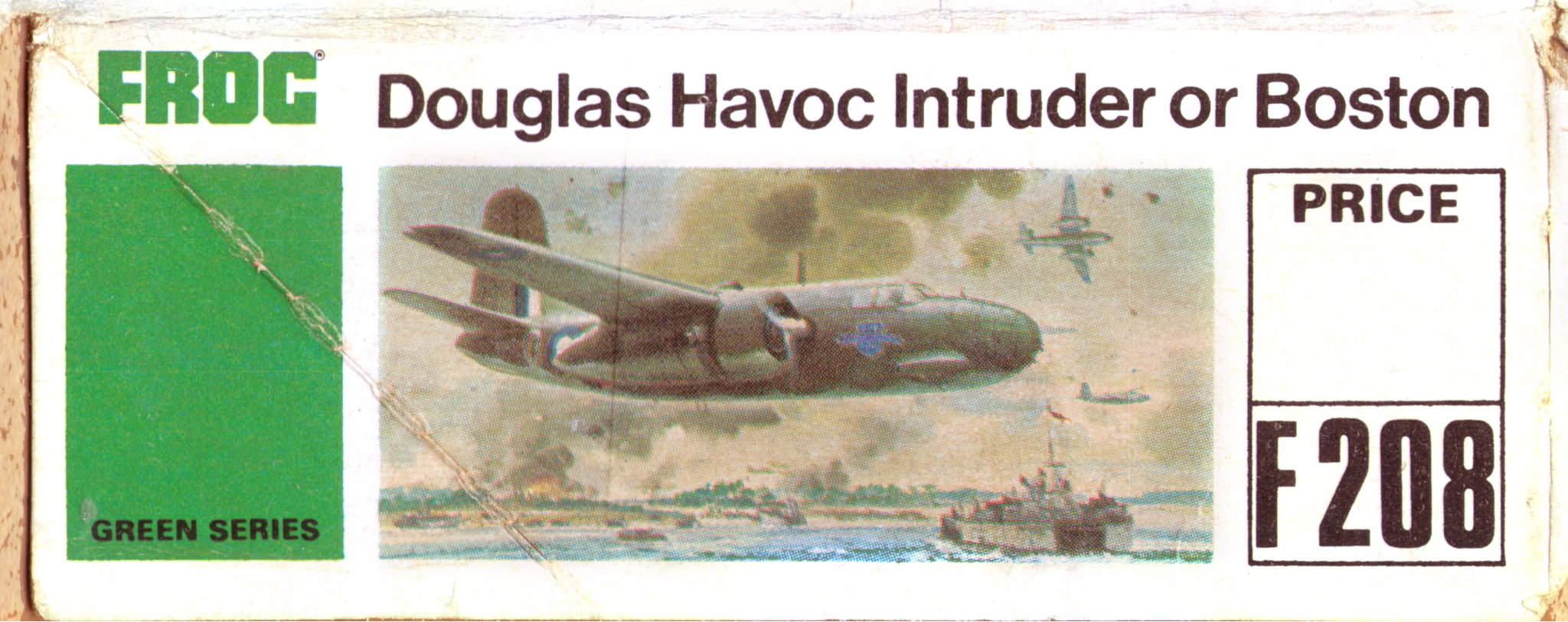



Douglas A-20C Havoc (Boston III)
| F208 | 1969-1974 | G1(G) | 135000 | 1xRAF & 1xRAAF |
FROG model aircraft 1932-1976, R. Lines, L. Hellstrom
|
|
NEW AND IN VIEW NEW AIRCRAFT KITS
IN VIEW (AIRCRAFT KITS)
FROG. The revised edition of their 1/72 scale kit of the Boston, now called the Havoc, has been released. The kit mouldings are little changed except that the mysterious 'bump' beneath the belly of the original kit has been removed.
Decals are excellent being for the Boston III flown by RAAF pilot F/Lt. W. T. Newton V.C. and alternatively for a Havoc Intruder of 418 (RCAF) Squadron, Bradwell Bay 1942.
The IPMS magazine, november 1969
"Monthly Review of new products
Frog also released at the same time a revised version of their older Boston kit, now re-boxed as a Douglas Havoc Intruder Boston, this kit has had many of the inaccuracies in fuselage shape removed and the new decals and box art are for a Boston III of 22 Squadron Royal Australian Air Force, as flown by F/Lt. W. T. Newton, RAAF V.C. and a Havoc Intruder of 418 Squadron R.C.A.F. Bradwell Bay 1942. The former having the glazed nose transparencies overpainted as was common on many Bostons used by the R.A.A.F. Some slight corrections to the fin and wing shapes are necessary for absolute accuracy and the Profile Publication on the Douglas Boston is a useful guide for this. The kit is moulded in grey plastic and the tongues for attaching the wings and tailplane to the fuselage require some trimming before they will slot into place correctly. The remainder of the kit fits together quite well. The transparencies are good, with the various canopy and other framework lines somewhat more finely detailed than of those in the original kit.
Decals are excellent and include the amusing personal markings for the R.A.A.F. machine of F/Lt. Newton, V.C. This is a welcome revision of the original Boston kit, and one that deserves a second look.
Bob Jones of IPMS
Scale Models 1970-02, New to you?"
NEW to YOU?
MONTHLY REVIEW OF NEW PRODUCTS CONDUCTED BY BOB JONES OF I.P.M.S
Frog also released at the same time a revised version of their older Boston kit, now re-boxed as a Douglas Havoc Intruder Boston, this kit has had many of the inaccuracies in fuselage shape removed and the new decals and box art are for a Boston III of 22 Squadron Royal Australian Air Force, as flown by F/Lt. W. T. Newton, RAAF V.C. and a Havoc Intruder of 418 Squadron R.C.A.F. Bradwell Bay 1942. The former having the glazed nose transparencies overpainted as was common on many Bostons used by the R.A.A.F. Some slight corrections to the fin and wing shapes are necessary for absolute accuracy and the Profile Publication on the Douglas Boston is a useful guide for this. The kit is moulded in grey plastic and the tongues for attaching the wings and tailplane to the fuselage require some trimming before they will slot into place correctly. The remainder of the kit fits together quite well. The transparencies are good, with the various canopy and other framework lines somewhat more finely detailed than of those in the original kit.
Decals are excellent and include the amusing personal markings for the R.A.A.F. machine of F/Lt. Newton, V.C. This is a welcome revision of the original Boston kit, and one that deserves a second look.
Scale Models No.5 1970 FEBRUARY Vol.1 No.5
"Modelling World
James Goulding
Recent FROG releases
Another kit from Frog is for the Douglas Boston III day bomber and night intruder (and not the Boston III and Havoc as claimed) and is in fact a re-work of the company's earlier Boston kit which, apart from one particularly odd feature, was always one of the better models of this very famous aircraft. The feature referred to was a peculiar, non-existent, change of profile along the bomb bay area. This must have been included originally because of a misinterpretation of a photograph or drawing, but has now been removed in this re-issue.
Generally the outline is reasonably good, and the finished model looks attractive. When checked against known dimensions, the depth of the fuselage and height of the fin are not as great as they should be—which result in the model looking slimmer than the real subject. Smoothing of the lower fuselage may have, of course, resulted in the reduction of the overall depth, but the fin and rudder should be higher by about a quarter of an inch. The contours of the fin and rudder top also need some modification.
Transfers included are for two aircraft, a Boston III day bomber of 22 Squadron, Royal Australian Air Force, based on Goodenough Island in 1943, and a Boston III night intruder of 418 Squadron, Royal Canadian Air Force, based at Bradwell Bay in late 1942. When the Boston Profile was published, the code letters of this aircraft were incorrectly shown in grey, but have been produced on the transfer in the correct Dull Red. One small omission on the transfer sheet for this aircraft are the rest of the words "Ottawa Ontario" which were written in small capitals after the machine letter "0". As seen in the photograph, they appeared in that form at least on the starboard side of the fuselage. The finish of this aircraft at this date was the sooty RDM2 black. Incidentally I have found a very realistic and pleasing RDM2 finish is obtained by giving a model one coat of Humbrol matt black, and, when dry, another coat of Downey's Acrylic Designers Gouache water colour paint, Black No Ao1, as I mentioned in the December 1969 issue. This acrylic paint is permanent when thoroughly dry and gives a completely matt finish without any sheen. It is available in small tubes, costing about 2s, and is very economical in use. It is mixed with water to the consistency of very thin cream, and if kept from drying out too rapidly a tube will be sufficient for many models. It would be advisable here to repeat my earlier warning to wash out thoroughly in water any brushes used with this paint—for unlike other water colour paint, dried brushes will not soften in water!
Returning to the subject of this review, the transparencies in this kit are a little disappointing in quality, but as I have said before these items are generally to a high standard in Frog kits. The contours of the nose glazing are not strictly correct, as they should be more tapered and have a bomb-aimer's flat window in the lower portion.
This is a useful re-release, and a good subject for the conversion enthusiast, with such possibilities as the many bomber variants and also the Havoc night fighters and intruders, including the Helmore Turbinlite Havoc.
This kit costs 6s.
Aircraft Illustration april 1970"
FROM FROG
THREE new kits from Frog, all to 1:72 scale, feature the Tupolev SB-2 bomber, the Douglas Boston (a re-issue), and the RA-5C Vigilante.
Second kit is the old Frog Boston III, now re-boxed and given new transfers and presentation. From memory of the original issue, there also appears to have been an attempt to iron out an inaccurate bump from the belly of the fuselage. New and attractive transfers are provided for a RAAF Boston III of 22 Sqn with an optional set for a Havoc Intruder of 418 Sqn RCAF. Particularly with the new transfers, this kit is definitely worthwhile as far as available Boston kits go. Price is 6s.
C.O.E.
Airfix Magazine, 1970-03, Vol.11 No.07
|